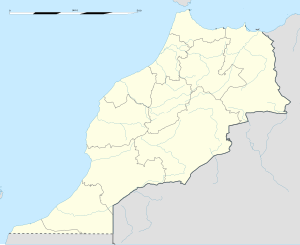Ifrane
|
Ifrane إفران ⵉⴼⵔⴰⵏ |
|
|---|---|

Ifrane in winter
|
|
 Openstreetmap of Ifrane |
|
| Location in Morocco | |
| Coordinates: 33°32′N 5°07′W / 33.533°N 5.117°W | |
| Country |
|
| Region | Fès-Meknès |
| Province | Ifrane |
| Elevation | 5,460 ft (1,665 m) |
| Population (2014) | |
| • Total | 73,782 |
| Time zone | WET (UTC+0) |
| • Summer (DST) | WEST (UTC+1) |
Ifrane[p] (Arabic: إفران ; Berber: ⵉⴼⵔⴰⵏ) is a city in the Middle Atlas region of Morocco (population 73,782 in November 2014). The capital of Ifrane Province in the region of Fès-Meknès, Ifrane is located at an elevation of 1,665 m (5,463 ft). In Tamazight, the regional Berber language, "ifran" means caves.
The modern town of Ifrane was established by the French administration in 1928 during the protectorate era for their administration due to its Alpine climate. Ifrane was conceived as a “hill station” or colonial type of settlement. It is a resort town set high up in the mountains so that Europeans can find relief from the summer heat of tropical colonies. Ifrane is also a popular altitude training destination.
The first permanent settlement of the area dates to the 16th century, when the Sharif of Sîdî 'Abd al-Salâm established his community in the Tizguit Valley, seven km downstream from the present town. Ifrane is a colonial “hill station”, and a “garden city”. It is also an “imperial city”, a mountain resort, a provincial administrative center, and a college town.
The first permanent settlement of the area dates to the 16th century, when a sharîf by the name of Sîdî ‘Abd al-Salâm established his community in the Tizguit Valley, seven km downstream from the present town. In Tamazight, the regional Berber language, yfran means “caves”. Sîdî ‘Abd al-Salâm’s village, called Zaouiat Sidi Abdeslam (or simply the zâwiyah), consisted at first of cave dwellings hollowed out of the limestone valley wall. Only in the last fifty years or so have its inhabitants build houses above ground. The caves which now lie under these houses are still used as mangers for animals and for storage.
By the mid-17th century Sîdî ‘Abd al-Salâm’s zâwiyah was well enough established to receive an extensive iqtâ’, or land grant, from the ‘Alâwî sultan Mûlây Rashîd b. Muhammad. The iqtâ’ extended from upstream of present Ifrane down the Tizguit valley all the way to El Hajeb escarpment. Late in the 19th century agro-pastoral groups of the Amazigh Senhadja Beni M’guild and Zenata the Ait Seghrouchen, crossing the Middle Atlas from the upper Moulouya Plain, started grazing their herds of sheep and goats on the surrounding plateau. The livelihood of the zâwiyah was based on irrigated agriculture on the valley floor, livestock grazing and forest resources.
...
Wikipedia

